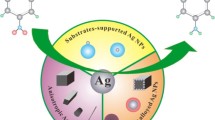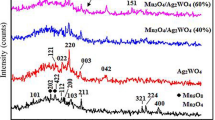Abstract
A green, facile, fast, and high throughput reusable catalytic reduction process was developed for the large-scale reduction of tris(p-nitrophenyl)amine to its corresponding amino-compound, tris(p-aminophenyl)amine (TAPA). The homogenous AgNPs and NaBH4 were used as the H-transfer catalyst and the H-donor compound, respectively. The successful reduction of TNPA was investigated by FT–IR, EDX, and XRD analysis, and its optical properties were checked by the UV–Visible and FL spectroscopies. Factors affecting the reduction yield including, temperature, reaction time, mmol of NaBH4, and catalyst volume, were optimized. Although the AgNPs are homogenous, both TNPA and TAPA are insoluble in water (AgNPs), hence the reduction process is heterogeneous. The importance of the heterogeneous reduction of TNPA was investigated, indicated that the reduction yield reached its maximum value when TNPA heterogeneously reduced on the surface of AgNPs. The reduction yield at optimal conditions was calculated at about 98.0% for the first and 72.0% after the 6th operational cycle, respectively. The mechanism of the reduction process was also established, indicated that the process works through a possible Langmuir–Hinshelwood mechanism. The easy recovery and excellent reusability of homogenous AgNPs along with high reaction yield reveal the power of the proposed method for the reduction of nitro-compounds.
Graphic abstract
Synopsis A high throughput reusable catalytic reduction process has developed for the reduction of tris(p-nitrophenyl)amine to its corresponding amino-compound, tris(p-aminophenyl)amine (TAPA) using the homogenous AgNPs the H-transfer. As a significant advantage, the developed method works through a green chemistry approach.





Similar content being viewed by others
References
Gu Y, Jiao Y, Zhou X, Wu A, Buhe B and Fu H 2018 Strongly coupled Ag/TiO2 heterojunctions for effective and stable photothermal catalytic reduction of 4-nitrophenol Nano Res. 11 126
Mitsudome T, Mikami Y, Matoba M, Mizugaki T, Jitsukawa K and Kaneda K 2012 Design of a silver–cerium dioxide core-shell nanocomposite catalyst for chemoselective reduction reactions Angew. Chem. Int. Ed. 51 136
Feng W, Huang T, Gao L, Yang X, Deng W, Zhou R and Liu H 2018 Textile-supported silver nanoparticles as a highly efficient and recyclable heterogeneous catalyst for nitroaromatic reduction at room temperature RSC Adv. 8 6288
Lauwiner M, Roth R and Rys P 1999 Reduction of aromatic nitro compounds with hydrazine hydrate in the presence of an iron oxide/hydroxide catalyst. III. The selective reduction of nitro groups in aromatic azo compounds Appl. Catal. A: Gen. 177 9
Gerelbaatar K, Tsogoo A, Dashzeveg R, Tsedev N and Ganbo E 2017 Reduction of 2,4-dinitrophenol to 2,4-diaminophenol using AuNPs and AgNPs as catalyst Solid State Phenom. 271 76
Millán R, Liu L, Boronat M and Corma A 2018 A new molecular pathway allows the chemoselective reduction of nitroaromatics on non-noble metal catalysts J. Catal. 364 19
Liu X, Cheng H and Cui P 2014 Catalysis by silver nanoparticles/porous silicon for the reduction of nitroaromatics in the presence of sodium borohydride Appl. Surf. Sci. 292 695
Rajesh R and Venkatesan R 2012 Encapsulation of silver nanoparticles into graphite grafted with hyperbranched poly(amidoamine) dendrimer and their catalytic activity towards reduction of nitro aromatics J. Mol. Catal. A: Chem. 359 88
Cho A, Byun S and Kim B M 2018 AuPd–Fe3O4 nanoparticle catalysts for highly selective, one-pot cascade nitro-reduction and reductive amination Adv. Synth. Catal. 360 1253
Shokouhimehr M 2015 Magnetically separable and sustainable nanostructured catalysts for heterogeneous reduction of nitroaromatics Catal. 5 534
Shokouhimehr M, Hong K, Lee T H, Moon C W, Hong S P, Zhang K, Suh J M, Choi K S, Varma R S and Jang H W 2018 Magnetically retrievable nanocomposite adorned with Pd nanocatalysts: Efficient reduction of nitroaromatics in aqueous media Green Chem. 20 3809
Qin L, Yi H, Zeng G, Lai C, Huang D, Xu P, Fu Y, He J, Li B, Zhang C and Cheng M 2019 Hierarchical porous carbon material restricted Au catalyst for highly catalytic reduction of nitroaromatics J. Hazard. Mater. 38 120864
Qin L, Huang D, Xu P, Zeng G, Lai C, Fu Y, Yi H, Li B, Zhang C, Cheng M and Zhou C 2019 In-situ deposition of gold nanoparticles onto polydopamine-decorated g-C3N4 for highly efficient reduction of nitroaromatics in environmental water purification J. Colloid Interf. Sci. 534 357
Hu Z, Zhou J, Ai Y, Liu L, Qi L, Jiang R, Bao H, Wang J, Hu J, Sun H B and Liang Q 2018 Two dimensional Rh/Fe3O4/g-C3N4-N enabled hydrazine mediated catalytic transfer hydrogenation of nitroaromatics: A predictable catalyst model with adjoining Rh J. Catal. 368 20
Krishna Kumar A S, You J G, Tseng W B, Dwivedi G D, Rajesh N, Jiang S J and Tseng W L 2019 Magnetically separable nanospherical g-C3N4@Fe3O4 as a recyclable material for chromium adsorption and visible-light-driven catalytic reduction of aromatic nitro compounds ACS Sustain. Chem. Eng. 7 6662
Payra S and Banerjee S 2019 Highly efficient and chemoselective reduction of nitroarenes using hybrid Ni@g-C3N4 as Reusable Catalyst ChemistrySelect 4 9556
Zhang K, Suh J M, Choi J W, Jang H W, Shokouhimehr M and Varma R S 2019 Recent advances in the nanocatalyst-assisted NaBH4 reduction of nitroaromatics in Water ACS Omega 4 483
Zhang K, Hong K, Suh J M, Lee T H, Kwon O, Shokouhimehr M and Jang H W 2019 Facile synthesis of monodispersed Pd nanocatalysts decorated on graphene oxide for reduction of nitroaromatics in aqueous solution Res. Chem. Intermed. 45 599
Li H, Yan X, Qiao S, Lu G and Su X 2018 Yellow-emissive carbon dots based optical sensing platform: cell imaging and analytical applications for biocatalytic reactions ACS Appl. Mater. Interfaces 10 7737
El-Mahdy A F, Kuo C H, Alshehri A, Young C, Yamauchi Y, Kim J and Kuo S W 2018 Strategic design of triphenylamine- and triphenyltriazine-based two-dimensional covalent organic frameworks for CO2 uptake and energy storage J. Mater. Chem. A 6 19532
Melánová K, Cvejn D, Bureš F, Zima V, Svoboda J, Beneš L, Mikysek T, Pytela O and Knotek P 2014 Organization and intramolecular charge-transfer enhancement in tripodal tris[(pyridine-4-yl)phenyl]amine push–pull molecules by intercalation into layered materials bearing acidic functionalities Dalton Trans. 43 10462
Kumar S 2006 Spectroscopy of Organic Compounds, Dept. of Chemistry, Guru Nanak Dev University, pages 14–16.
Hormozi Jangi S R, Akhond M and Dehghani Z 2020 High throughput covalent immobilization process for improvement of shelf-life, operational cycles, relative activity in organic media and enzymatic kinetics of urease and its application for urea removal from water samples Process Biochem. 90 102
Sun S, Shu Q, Lin P, Li Y, Jin S, Chen X and Wang D 2016 Triphenylamine based lab-on-a-molecule for the highly selective and sensitive detection of Zn2+ and CN- in aqueous solution RSC Adv. 6 93826
Bureˇs F 2014 Fundamental aspects of property tuning in push–pull molecules RSC Adv. 4 58826
Li R S, Liu H, Chen B B, Zhang H Z, Huang C Z and Wang J 2016 Stable gold nanoparticles as a novel peroxidase mimic for colorimetric detection of cysteine Anal. Methods 8 2494
Akhond M, Hormozi Jangi S R, Barzegar S and Absalan G 2020 Introducing a nanozyme-based sensor for selective and sensitive detection of mercury (II) using its inhibiting effect on production of an indamine polymer through a stable n-electron irreversible system Chem. Pap. 74 1321
Acknowledgement
The authors wish to acknowledge the support of this work by Shiraz University Research Council.
Author information
Authors and Affiliations
Corresponding author
Ethics declarations
Conflicts of interest
The authors declare that they have no known competing for financial interests or personal relationships that could have appeared to influence the work reported in this paper.
Electronic supplementary material
Below is the link to the electronic supplementary material.
Rights and permissions
About this article
Cite this article
HORMOZI JANGI, S.R., AKHOND, M. High throughput green reduction of tris(p-nitrophenyl)amine at ambient temperature over homogenous AgNPs as H-transfer catalyst. J Chem Sci 132, 110 (2020). https://doi.org/10.1007/s12039-020-01819-9
Received:
Revised:
Accepted:
Published:
DOI: https://doi.org/10.1007/s12039-020-01819-9




